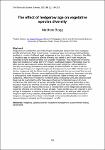The effect of hedgerow age on vegetative species diversity
| dc.contributor.author | Blogg, M. | |
| dc.date.accessioned | 2023-12-22T15:45:03Z | |
| dc.date.available | 2023-12-22T15:45:03Z | |
| dc.date.issued | 2023 | |
| dc.identifier.citation |
Blogg, M. (2023) 'The effect of hedgerow age on vegetative species diversity', The Plymouth Student Scientist, 16(2), pp. 199-223. | en_US |
| dc.identifier.uri | https://pearl.plymouth.ac.uk/handle/10026.1/21839 | |
| dc.description.abstract |
Hedgerows are a distinctive part of the English countryside and provide many ecological benefits and services. Over recent history, hedgerows have been removed and replanted, resulting in a matrix of different aged hedgerows across the country. In this study, the effect of hedgerow age on vegetative species diversity was tested to see if older hedgerows contained a higher species diversity than younger hedgerows. Four hedgerows of varying ages were tested on an urban farm in Plymouth, Southwest England. Percentage cover of each species was measured across ten samples in each hedgerow, with a Shannon’s diversity score being calculated for each sample and then repeated for each of the four different aged hedgerows. Vegetative species diversity was found to differ between each of the four hedgerows with the Devon bank having the highest diversity score and the orchard hedgerow the lowest. Although some significant differences were found, these were not able to conclude that older hedgerows contain a significantly higher diversity than younger hedgerows. Differences in hedgerow functional group composition were also observed and these may be due to factors other than age such as surrounding land use or structure. Furthermore, the distribution of autumn and winter fruiting species was tested due to their ecological importance and was found that a higher proportion was contained within the old hedgerow. It could be implied that the lack of management on the hedgerows sampled was negatively affecting their diversity through all ages. Future studies would be required to see if the age of hedgerows is influencing diversity and composition by testing a wider range of hedgerow ages and by sampling during different seasons. Recommendations for future hedgerow management have been made based on the surrounding literature in order to improve hedgerow diversity and its subsequent benefits. | en_US |
| dc.language.iso | en | en_US |
| dc.publisher | University of Plymouth | en_US |
| dc.rights | Attribution 3.0 United States | * |
| dc.rights.uri | http://creativecommons.org/licenses/by/3.0/us/ | * |
| dc.subject | Hedgerow | en_US |
| dc.subject | species diversity | en_US |
| dc.subject | hedgerow management | en_US |
| dc.subject | autumn/winter fruiting | en_US |
| dc.subject | Devon bank | en_US |
| dc.title | The effect of hedgerow age on vegetative species diversity | en_US |
| dc.type | Article | en_US |
| plymouth.issue | 2 | |
| plymouth.volume | 16 | |
| plymouth.journal | The Plymouth Student Scientist |



